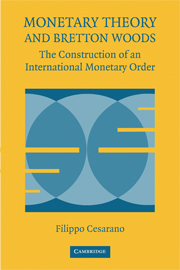Book contents
- Frontmatter
- Contents
- Preface
- Acknowledgments
- 1 INTRODUCTION
- 2 INTERNATIONAL MONETARY EQUILIBRIUM AND THE PROPERTIES OF THE GOLD STANDARD
- 3 THE INTERNATIONAL MONETARY SYSTEM BETWEEN THE WORLD WARS
- 4 THE MONETARY SYSTEM IN ECONOMIC ANALYSIS: THE CRITIQUE OF THE GOLD STANDARD
- 5 THE GREAT DEPRESSION: OVERTURNING THE STATE OF THE ART
- 6 PROVIDING FOR A NEW MONETARY ORDER
- 7 THE BRETTON WOODS AGREEMENTS
- 8 BRETTON WOODS AND AFTER
- References
- Author Index
- Subject Index
8 - BRETTON WOODS AND AFTER
Published online by Cambridge University Press: 18 December 2009
- Frontmatter
- Contents
- Preface
- Acknowledgments
- 1 INTRODUCTION
- 2 INTERNATIONAL MONETARY EQUILIBRIUM AND THE PROPERTIES OF THE GOLD STANDARD
- 3 THE INTERNATIONAL MONETARY SYSTEM BETWEEN THE WORLD WARS
- 4 THE MONETARY SYSTEM IN ECONOMIC ANALYSIS: THE CRITIQUE OF THE GOLD STANDARD
- 5 THE GREAT DEPRESSION: OVERTURNING THE STATE OF THE ART
- 6 PROVIDING FOR A NEW MONETARY ORDER
- 7 THE BRETTON WOODS AGREEMENTS
- 8 BRETTON WOODS AND AFTER
- References
- Author Index
- Subject Index
Summary
The evolution of the monetary system is governed by the interaction between advances in economic theory and major shocks. This hypothesis is corroborated by the articulated process that led from the downfall of the gold standard to the Bretton Woods agreements and then to the sudden abandonment of the spirit of the treaty. A detailed examination of the actual working of Bretton Woods, however, is beyond the scope of the present work. This concluding chapter thus focuses exclusively on the factors behind the system's eventual collapse and the prospects for the development of the international monetary system.
The Bretton Woods conference was unique to monetary history. It designed a new monetary order from scratch. John Ikenberry, for one, noted:
The Bretton Woods agreements, negotiated largely between Britain and the United States and signed by forty-four nations in 1944, were remarkable in a variety of ways. First, they represented an unprecedented experiment in international rule making and institution building – rules and institutions for post-war monetary and financial relations. Second, the Bretton Woods agreements were the decisive step in the historic reopening of the world economy. Agreement was reached, at least in principle, whereby the world economy would abandon regional currency and trade groupings in favor of a liberal multilateral system. Third, Bretton Woods created an entirely new type of open system – something that the capitalist world had not seen before. The Anglo-American agreements established sophisticated rules that would attempt to reconcile openness and trade expansion with the commitments of national governments to full employment and economic stabilization.[…]
- Type
- Chapter
- Information
- Monetary Theory and Bretton WoodsThe Construction of an International Monetary Order, pp. 188 - 216Publisher: Cambridge University PressPrint publication year: 2006



